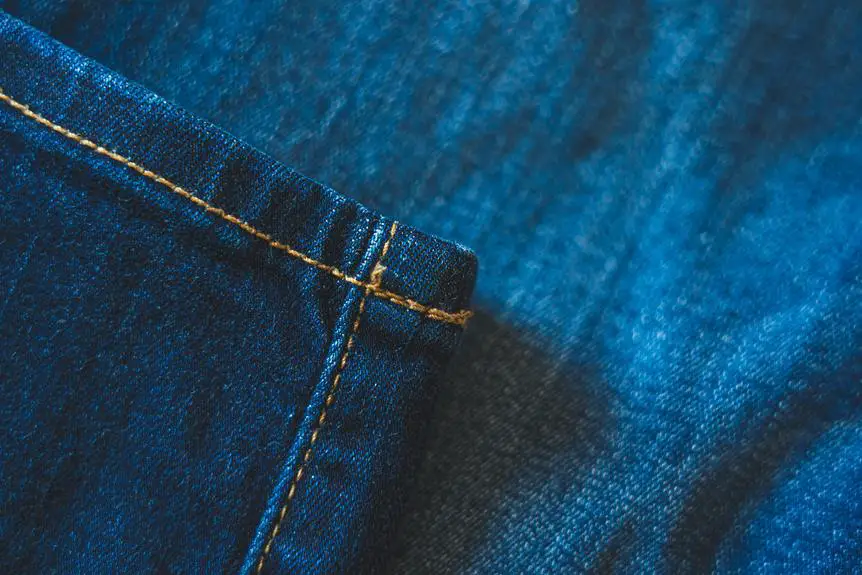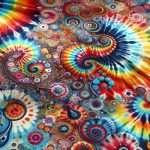When you're considering fabrics that can maintain vibrant colors over time, it's important to think about both natural and synthetic options. You might find that synthetic fibers like polyester and nylon stand out for their resilience against fading, while natural fibers can surprise you with their eco-friendly potential. But what if there's more to this story than just durability? Understanding the different types of dyes used and how they interact with various materials can make all the difference in your choices. Let's explore what really keeps colors alive in fabric.
Table of Contents
Key Takeaways
- Natural fibers like cotton and silk offer vibrancy but may fade faster; proper care is essential for maintaining color longevity.
- Synthetic fibers such as polyester and nylon provide superior durability and color retention, making them ideal for long-lasting garments.
- Reactive dyes bond chemically with fibers, resulting in bright, long-lasting colors compared to direct dyes, which can fade more quickly.
- Fabrics with a tightly woven construction tend to be more durable and resistant to fading, enhancing color retention over time.
Understanding Fabric Dyes
To choose fabrics that maintain vibrant colors, you first need to understand how different fabric dyes work.
Fabric dyes fall into two main categories: reactive and direct dyes. Reactive dyes bond chemically with the fabric fibers, resulting in bright, long-lasting colors. They're typically used on natural fibers like cotton and silk, making them a popular choice for vibrant, durable clothing.
On the other hand, direct dyes are applied simply and are often less expensive, but they tend to fade more quickly. They're suitable for fabrics like polyester, though the vibrancy mightn't match that of reactive dyes. If you're aiming for longevity, opt for fabrics dyed with reactive dyes.
Another crucial aspect is the dyeing process itself. Fabrics that undergo proper pre-treatment and post-treatment processes usually retain their colors better. Always consider the manufacturer's recommendations, as they can provide insight into the dyeing methods used.
Additionally, pay attention to the colorfastness rating, which indicates how well a dye resists fading from washing and exposure to light.
Understanding these dye principles will help you choose fabrics that not only look stunning but also stand the test of time.
Natural Vs. Synthetic Fibers
Natural and synthetic fibers each offer unique advantages when it comes to color retention and overall durability.
If you're considering natural fibers like cotton, wool, or linen, you'll appreciate their breathability and softness. However, keep in mind that they can be more susceptible to fading when exposed to sunlight or harsh washing conditions. These fibers often require special care to maintain their vibrant colors over time.
On the other hand, synthetic fibers such as polyester and nylon are engineered for longevity. They tend to retain colors better, thanks to their resistance to fading and shrinking. You'll find that synthetic fabrics can withstand sun exposure and rigorous washing without losing their vibrancy. Plus, they're often more affordable, making them a practical choice for everyday use.
Ultimately, your decision may depend on your specific needs. If you prioritize comfort and eco-friendliness, natural fibers could be your go-to. However, if you're looking for durability and easy maintenance, synthetic fibers might be the way to go.
Weigh the pros and cons of each type to find the best fit for your projects and lifestyle.
Best Fabrics for Clothing
When choosing the best fabrics for clothing, you'll want to consider the advantages of natural fibers, like breathability and comfort.
Synthetic fibers, on the other hand, offer impressive durability and resistance to fading.
Don't forget how different dyeing techniques can also impact the longevity of color in your garments.
Natural Fiber Advantages
Choosing natural fibers for clothing not only enhances comfort but also ensures vibrant, long-lasting color that stands the test of time. Fabrics like cotton, linen, and wool offer a variety of benefits that synthetic options simply can't match.
First, natural fibers breathe well, allowing air circulation that keeps you cool and comfortable. This breathability also helps prevent color fading caused by trapped moisture and heat. Additionally, natural fibers often have a unique texture that adds depth and character to your wardrobe, making your outfits feel more luxurious.
Moreover, the dyes used in natural fibers tend to be more eco-friendly, which means they're less likely to harm the environment. These dyes often penetrate the fabric deeply, resulting in colors that remain rich and vivid over time.
You'll also find that natural fibers are less likely to irritate sensitive skin, making them an ideal choice for everyday wear.
When you invest in clothing made from natural materials, you're not just choosing comfort and style; you're opting for durability and sustainability, ensuring your wardrobe stays vibrant for years to come.
Synthetic Fiber Durability
While natural fibers offer numerous benefits, synthetic fibers provide unmatched durability that can withstand the rigors of everyday wear. When you're looking for clothing that lasts, consider the advantages of synthetic fabrics. They resist wrinkles, fading, and tearing, making them ideal for active lifestyles.
Here's a quick comparison of some popular synthetic fibers:
| Fiber Type | Durability Rating | Best Uses |
|---|---|---|
| Polyester | 4/5 | Sportswear, casual wear |
| Nylon | 5/5 | Activewear, outerwear |
| Spandex | 3/5 | Activewear, swimwear |
| Acrylic | 3/5 | Sweaters, blankets |
| Rayon | 2/5 | Dressy garments |
When you choose synthetic fabrics, you're investing in clothing that not only maintains its color but also stands up to daily challenges. These materials dry quickly, making laundry days easier, and they often require less frequent washing. So, if you want your wardrobe to stay vibrant and resilient, synthetic fibers are a smart choice.
Dyeing Techniques Impact
Dyeing techniques greatly influence how well fabrics retain color, impacting the longevity and vibrancy of your clothing. When choosing fabrics, consider how they're dyed.
Direct dyeing, for instance, penetrates the fibers, ensuring a deeper hue, but may fade quicker with washing. On the other hand, reactive dyes chemically bond with the fabric, leading to vibrant and long-lasting colors.
You should also pay attention to dyeing methods like tie-dye or batik. These techniques add unique patterns but can lead to uneven color retention. If you love bold colors, fabrics dyed using methods like acid dyeing or vat dyeing often exhibit superior colorfastness, making them ideal for your wardrobe.
Don't forget about pre-treatment processes, which enhance color retention. Fabrics that undergo mordanting, for example, tend to hold dyes better, resulting in richer and more durable shades.
Ultimately, the combination of fabric type and dyeing technique plays a crucial role in how well your clothes maintain their color over time. By understanding these factors, you can make smarter choices that keep your wardrobe looking fresh and vibrant for years.
Top Choices for Upholstery
When it comes to upholstery, you'll want fabrics that stand the test of time while keeping their color vibrant.
Durable synthetic materials offer excellent resistance to fading, while natural fiber options bring warmth and richness to your space.
Let's explore these top choices to help you make the best decision for your furniture.
Durable Synthetic Materials
Durable synthetic materials like polyester and nylon are your best bets for upholstery that maintains its vibrant color over time. These fabrics resist fading, making them ideal for high-traffic areas where exposure to sunlight is a concern.
Polyester, in particular, is known for its incredible resilience. It withstands wear and tear while retaining its shape and color, ensuring your furniture looks fresh for years.
Nylon is another excellent choice, offering superior strength and stain resistance. It's less prone to fading than natural fibers, so you won't have to worry about dull colors after repeated cleanings.
Both materials are easy to clean, which is a significant advantage if you have kids or pets.
When selecting upholstery, consider options treated with colorfast dyes, as these enhance longevity. Additionally, look for fabrics that are woven tightly; this not only increases durability but also helps minimize fading.
Natural Fiber Options
While synthetic fabrics are popular for their longevity, natural fiber options can also offer beautiful aesthetics and a range of durability, making them worthy contenders for upholstery. When you choose natural fibers, you're not just investing in a sustainable choice; you're also securing unique textures and colors that can enhance any space.
Here are some top natural fiber options for upholstery:
| Fiber Type | Durability Level |
|---|---|
| Cotton | Moderate |
| Linen | High |
| Wool | High |
| Silk | Moderate |
Cotton is versatile and easy to clean but may fade quicker than others. Linen, on the other hand, boasts a refined look and excellent breathability, making it ideal for warm climates. Wool is incredibly durable and resistant to stains, while silk offers a luxurious feel but requires more careful maintenance.
Choosing the right natural fiber depends on your lifestyle and aesthetic preferences. With the right selection, you can enjoy beautiful upholstery that stands the test of time, all while embracing the charm of natural materials.
Care Tips for Color Retention
To keep your fabrics vibrant, always wash them in cold water and turn them inside out before laundering. This simple step helps reduce friction and preserves the dye, preventing it from fading. When using a washing machine, opt for a gentle cycle to further protect your clothes.
Avoid harsh detergents and bleach, as these can strip color from your fabrics. Instead, choose a mild detergent specifically designed for colored items. You might also consider adding a color-safe fabric softener, which can help maintain the softness and appearance of your textiles.
Dry your garments in the shade whenever possible. Sunlight can fade colors quickly, so air drying indoors or in a shaded area is best. If you must use a dryer, select a low heat setting to minimize damage.
For items that require ironing, use a low-temperature setting and iron them inside out. This technique prevents direct heat from affecting the fabric's color.
Lastly, store your clothes in a cool, dark place, as prolonged exposure to light can cause colors to dull over time. Following these care tips will help ensure your fabrics stay looking fresh and vibrant for years to come.
Testing Fabric Durability
Testing fabric durability involves assessing how well a material can withstand wear and tear over time. To do this, you should consider various factors like tensile strength, abrasion resistance, and colorfastness.
Start by examining the fabric's construction. A tightly woven fabric often indicates better durability than a loosely woven one.
Next, perform a simple abrasion test. Take a piece of sandpaper or a rough surface and rub it against the fabric. Check for pilling or fraying, which can indicate how well the fabric will hold up in everyday use.
You can also conduct a tensile strength test by pulling the fabric in opposite directions to see how much force it can endure before breaking.
Another important aspect is colorfastness. Wash the fabric several times to see if the color fades or bleeds. You can also expose it to sunlight to evaluate how well it retains its color when subjected to UV rays.
Sustainable Options for Vibrant Colors
Sustainable fabrics can deliver vibrant colors without compromising the environment, making them an excellent choice for eco-conscious consumers. You'll find that these materials not only look great but also help reduce your carbon footprint.
Consider the following sustainable options that provide rich hues:
| Fabric Type | Color Benefits |
|---|---|
| Organic Cotton | Naturally dyed, soft textures |
| Tencel | Breathable, vibrant shades |
| Recycled Polyester | Bright, long-lasting colors |
| Hemp | Earthy tones, fades less |
Organic cotton is grown without harmful pesticides, allowing for a softer feel and vibrant colors. Tencel, made from sustainably sourced wood pulp, offers a luxurious touch with excellent dye absorption. Recycled polyester keeps plastics out of landfills while maintaining bright hues, and hemp not only provides unique earthy tones but also ages gracefully.
Frequently Asked Questions
How Can I Tell if Fabric Has Been Pre-Treated for Color Retention?
You can check fabric labels for terms like “colorfast” or “pre-treated.” Additionally, asking the retailer about their dyeing process and any treatments used can give you more insight into the fabric's color retention properties.
Do Different Dyeing Techniques Affect Color Longevity?
Absolutely, different dyeing techniques can significantly affect color longevity. Techniques like reactive dyeing usually produce vibrant, long-lasting colors, while others may fade faster. You should consider both the dyeing method and fabric type for optimal results.
Can I Use Fabric Softeners on Colorfast Materials?
Yes, you can use fabric softeners on colorfast materials. Just make sure to choose a gentle, dye-free option to avoid any potential fading or unwanted residue that could affect the fabric's appearance over time.
Are There Specific Brands Known for Color Durability?
When you're searching for brands known for color durability, consider options like Carhartt, Patagonia, and Lands' End. They've built reputations for quality products that maintain vibrant colors even after multiple washes. You won't be disappointed!
What Role Does Fabric Weight Play in Color Retention?
Fabric weight significantly impacts color retention. Heavier fabrics often hold dyes better, reducing fading over time, while lighter fabrics may lose color more quickly. Choosing the right weight can enhance the longevity of your fabric's vibrancy.
- How Does Ring Spun Cotton Affect Garment Fit and Shape Retention? - August 13, 2024
- What Are the Challenges in Producing Ring Spun Cotton? - August 13, 2024
- Is Ring Spun Cotton Suitable for Plus-Size Clothing? - August 13, 2024







